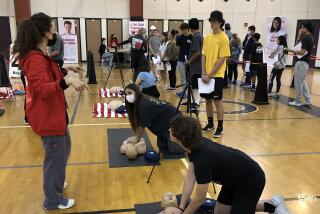Modified Plumber’s Plunger May Aid CPR
- Share via
A modified toilet plunger developed at the University of California may work significantly better than conventional CPR to resuscitate heart attack victims, according to results of a trial reported today in the Journal of the American Medical Assn.
The device was developed by UC physicians who treated a man whose son had used a toilet plunger to resuscitate him. It is essentially a suction cup that expands the lungs when it is pulled away from the chest.
Patients treated with the device were more likely to survive than those who were treated with conventional cardiopulmonary resuscitation in the 130-patient trial. But the results were not statistically significant because the study--and four others like it--was terminated by the U.S. Food and Drug Administration because informed consent was not obtained from participants.
Proponents are calling for a larger study of the device, called the Ambu CardioPump, which is approved for use throughout much of the world, including Canada, England and most of Europe. The new technique is called active compression-decompression CPR.
In conventional CPR, intermittent pressure is applied to the chest to stimulate the heart and air is forced into the lungs through the mouth. In the new method, the suction device is pressed to the sternum and withdrawn repeatedly. This action not only stimulates the heart, but inflates and deflates the lungs as well.
The trial was conducted in St. Paul, Minn., said Dr. Keith G. Lurie of the University of Minnesota. Lurie co-invented the CardioPump while he was a faculty member at UC San Francisco.
Over a 10-month period, 77 patients received standard CPR and 53 received the new method. The team reported that 26% of the patients who received standard CPR were revived and admitted to intensive care units, while 40% of those who received the new treatment were admitted. The remainder of the heart attack victims died. But because the study was ended early, the team did not study a large enough number of patients for the results to be ascribed to use of the new method rather than chance, Lurie said.
Better results were achieved when the group considered only patients who were treated within 10 minutes of their heart attack. Among this group, 38% of those treated by the new method were eventually released from the hospital, compared to 20% of those treated with standard CPR. “These results are statistically significant” because the differences in results between the two groups is larger, even though a smaller number of people were involved, Lurie said.
The study was ended last year by the FDA, which has sharply limited most clinical trials of resuscitation techniques, Dr. Carin M. Olson, a contributing editor of JAMA, wrote in an accompanying editorial. The problem is the difficulty in obtaining informed consent from patients or their families for participation in a clinical trial.
In these cases, the patients are too sick to give permission, and family members are either not present or too distraught to give consent in the short time available before treatment must be begun. The researchers obtained permission from relatives after the fact, a concept called deferred consent.
But the FDA recently decided that it would no longer accept trials involving deferred consent, Olson said. Considering the potential benefits of the Ambu CardioPump and other potential resuscitation devices and techniques, Olson said, the FDA rules are absurd.






